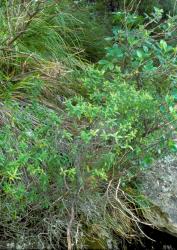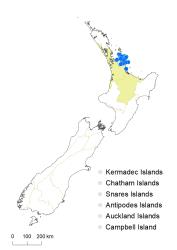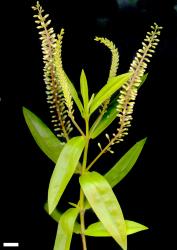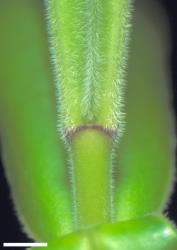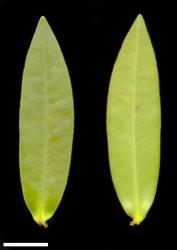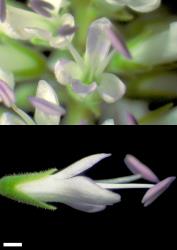- ≡ Hebe pubescens (Benth.) Cockayne & Allan, Trans. New Zealand Inst. 57: 17 (1926) subsp. pubescens
Shrub to 2 m tall, usually erect. Branchlets uniformly hairy; hairs of varying length from quite short to long and woolly. Leaf bud sinus small, rounded to square or oblong, often filled with hairs. Leaves lanceolate, oblong, elliptic, or linear, sub-coriaceous to coriaceous, 15–87 mm long, 3.5–18.0 mm wide, dark to yellowish-green above; midrib beneath and usually surface beneath eglandular-hairy with hairs >0.2 mm long; margins pubescent. Inflorescence 20–200 mm long. Calyx lobes hairy on outer surfaces. Corolla tube 1.9–3.9 mm long; lobes eglandular-hairy on outer faces. Ovary and capsules usually hairy, sometimes glabrous; capsules 3–4 mm long.
V. pubescens subsp. pubescens plants can be distinguished by the long hairs on the midribs, margins, and especially undersides of the leaf lamina, although at some localities (e.g., Kauaeranga Valley, Lonely Bay, and some islands near Coromandel Peninsula) leaves may be less hairy. I have included in the circumscription some plants from islands on the western side of the Firth of Thames because their leaf buds have small sinuses, but these have quite short hairs and should be closely compared with V. stricta with respect to other characters.
Three other hebes, V. corriganii, V. macrocarpa, and V. stricta, grow on Coromandel Peninsula.
Plants of V. corriganii are found south of the distribution of V. pubescens and differ in being less hairy and having shorter hairs, rounded corolla lobes, and larger capsules.
Plants of V. macrocarpa lack a leaf bud sinus, are less hairy and with shorter hairs, have larger and more robust flowers with rounded corolla lobes, and larger fruits.
Plants of V. stricta in northern New Zealand can be quite hairy, but can be distinguished from V. pubescens subsp. pubescens by their generally shorter hairs, glabrous leaves beneath, and the absence of a sinus in the leaf bud. In V. stricta the corolla lobes are generally shorter and narrower, glabrous on the outer faces, and do not open so widely.
North Island: Auckland (Coromandel Peninsula, Motukawao Group, Ngamotukaraka Is. / Three Kings Is., Waimate, Motuoruhi and Motukaramea I. / Kaikai I., Mercury Is.). Some specimens from islands in the western Firth of Thames are also included in the distribution mapped here, discussed under ‘Recognition’.
Coastal sites under pōhutukawa forest, cliffs, rock-strewn ground, slip scars, coastal rocks; inland on disturbed sites in open seral vegetation. Recorded elevations range from 5 to 609 m.
Flowers: August–May; fruits: August–May, persisting all year.
2n = 40 (see Bayly & Kellow 2006, as Hebe pubescens subsp. pubescens).



